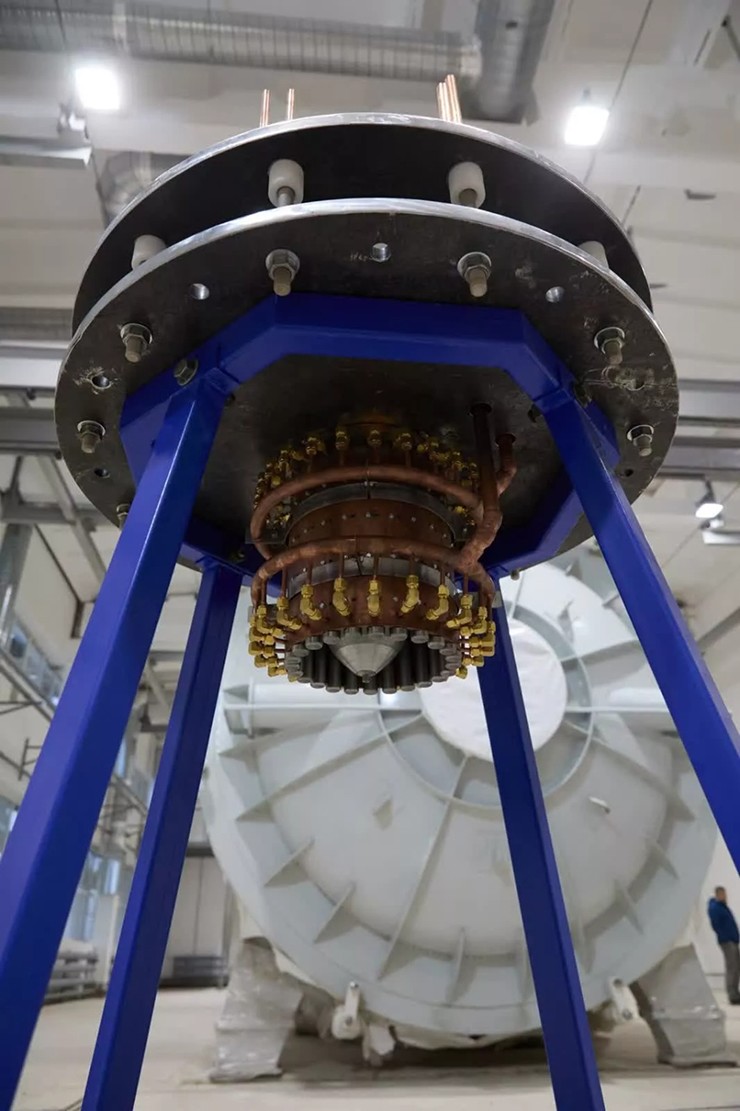Russia develops technology to help send humans to Mars in just 1 month
Accordingly, the Russian State Atomic Energy Corporation, Rosatom, has developed a new spacecraft engine with impressive specifications, far exceeding the capabilities of traditional chemical rocket engines. This engine can generate a thrust of at least 6 N and a specific impulse of at least 100 km/s.
 Russia develops technology to help send humans to Mars in just 1 month Picture 1
Russia develops technology to help send humans to Mars in just 1 month Picture 1
Plasma engine prototype developed by Russian scientists.
Based on magnetic plasma accelerator technology, this propulsion system has the potential to significantly reduce travel times between planets, with the ability to send humans to Mars in just 1 to 2 months.
Alexey Voronov, deputy director general for science at Rosatom, said: 'Currently, a flight to Mars using a conventional engine can take almost a year, which is very dangerous for astronauts due to cosmic radiation. Using a plasma engine could shorten the mission duration to 30-60 days, allowing astronauts to go to Mars and return safely.'
Plasma engines work on a different principle than conventional rockets. Researcher Egor Biriulin explains that the engine is an electric propulsion system with two electrodes. When charged particles move between them and a high voltage is applied, the current creates a magnetic field, which pushes the particles out of the engine and creates thrust. With an output power of about 300 kW, the new plasma engine can accelerate charged particles – electrons and protons – to speeds of 100 km/s, far exceeding the maximum speed of about 4.5 km/s of conventional power units.
 Russia develops technology to help send humans to Mars in just 1 month Picture 2
Russia develops technology to help send humans to Mars in just 1 month Picture 2
The travel time from Earth to Mars is currently about 1 year.
Rosatom will test the technology on a large-scale test stand in Troitsk, the main device of which is a vacuum chamber 4 meters in diameter and 14 meters long. The device will be equipped with high-performance vacuum pumping and heat removal systems, allowing it to simulate the conditions of deep space.
One of the main advantages of the new engine is its energy efficiency. Biriulin says the plasma doesn't need to be heated as much, which helps keep the engine's components from overheating. The engine is also capable of converting almost all of its electrical energy into motion.
While plasma engines will not completely replace chemical rockets in the initial stages of launch, they will play an important role once spacecraft reach orbit. The technology could be used in the future to transport cargo between planets.
 Russia develops technology to help send humans to Mars in just 1 month Picture 3
Russia develops technology to help send humans to Mars in just 1 month Picture 3
It should be noted, however, that the engine is still in the prototype stage and there is much development work to be done before Rosatom can use it in manned space missions. Although the team has conducted more than 2,400 hours of testing, assessing the engine's capabilities will take time as it has not been tested in space-like conditions for a long time.
The development of this plasma engine is part of Rosatom's larger initiative to advance space exploration technology, which includes the development of nuclear power plants for various space applications and automated control systems for spacecraft.
You should read it
- 3D print missiles will be used to bring satellites to space in the future
- The team created a microwave-jet plasma engine, wishing to replace the existing aircraft engine
- How terrible is the rocket that will bring people to Mars?
- Impressed by a slow-motion shot of a rocket engine in a water tank
- NASA began assembling Mars 2020 spacecraft
- SpaceX reveals photos showing the terrifying power of Starship's Raptor engine
- Choose 3D TV with LED or Plasma technology
- Falcon Heavy - The world's most powerful super rocket can reach thrust of more than 2,300 tons
- Details of the plan to turn a successful Mars man for only $ 100,000 by Elon Musk
- Current and future display technology (part I)
- CES 2014 - LED TVs will replace Plasma
- Rotating rocket engines can help aircraft reach speeds of Mach 9
May be interested

Entrance to the world of alien life revealed in Ariel?

Elon Musk's SpaceX Era Could Cause Aviation Disasters

Japan successfully launched the world's first wooden satellite into space.

An ancient asteroid once collided with and 'flipped' Jupiter's moon Ganymede

The 5 largest aircraft in the world are dominating the skies

Mars has a huge water ocean – but deep underground






 Mars: Overview of the 4th planet in the solar system
Mars: Overview of the 4th planet in the solar system How does human body change in Mars?
How does human body change in Mars? Find the right place for humans to migrate more than Mars, and it is in the solar system
Find the right place for humans to migrate more than Mars, and it is in the solar system Sign up now and always with NASA to be SIGNED ASKED
Sign up now and always with NASA to be SIGNED ASKED Looking back at NASA's Mars exploration process over the past 20 years
Looking back at NASA's Mars exploration process over the past 20 years How will the world change in the next 1000 years?
How will the world change in the next 1000 years?